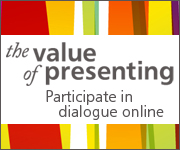We recently did some research and strategy work with Ottawa Storytellers (OST). Their goal was to further build on their existing audience with a focus on cultivating a younger, more culturally diverse audience.
With storytelling the challenge is two-fold: 1) many people do not think of storytelling as a professional, adult performing art; and 2) event promotion has not built broad-based trust and credibility in organizations producing or presenting storytelling events.
The challenge we faced was that OST needed to build much greater recognition for itself as a credible and trustworthy source of quality performing arts/ storytelling events and for storytelling as a bona fide professional art form with every communication touch point. At the same time, it needed to “sell” storytelling series or individual performances, without being encumbered by organization-level messaging.
Often in event-based marketing – and when marketing budgets are relatively small – there is little leverage or recognition accruing back to the arts presenter, except among the most committed audiences. That in turn creates long-term liabilities like needing to continually invest in one-off marketing of events, rather than being able to benefit over time from a mother brand approach where recognition, trust and credibility reside with the presenter, not only a specific artist/event. Such an approach creates all kinds of benefits such as more easily presenting new artists through reducing box office risk and more effective marketing. It was also important to understand that when growing an audience is the central goal then the strategy cannot rely on largely list-based marketing efforts alone.
Central Strategy: Mother Brand
That is why a central part of our strategy called for a new branding approach that would be cohesive, bold, contemporary, intelligent, easily structured and flexible in application, welcoming and inviting to audiences, and give weight to OST (this is where the relationship with the audience gets built) while also giving strong presence to show-specific information (which is where OST fulfills its artistic mission).
In short, OST needed to take its place at the heart of its marketing. It would be the mother brand from which all series and events would flow.
In our analysis, we had found the OST logo and tagline were already strong and we recommended keeping both. We found that many of their marketing and communications tactics including much of their online efforts were well conceived and executed. The visual branding, on the other hand, was less effective, too complex and hard to adapt. Similarly, there was, at times, no clear hierarchy of messages evident in marketing materials and the oft-observed “too much text, which ends up saying very little to anyone” was also sometimes an issue.
Creative Brief: Define Audience Using Psychographics
By defining the audience, we were able to create a target that felt real. We used a psychographic composite (values, beliefs, generation-based experiences), rather than just relying on demographic elements (age, income, etc) which are less meaningful, and certainly much less so in terms of creative direction.
OST has just launched its new web site which features its new branding approach. I think they did an excellent job translating the strategic direction into an effective brand architecture.
 What do you think?
What do you think?
Thank you to OST for agreeing to share the back story on its new strategy initiatives.






